Contractors
Hiro Hashimoto
- Hashimoto Construction Limited
- 1923–2000
Biography
Hiro Hashimoto was born in Mission, British Columbia, on July 25, 1923, to parents Ruiichi and Sato. There, he worked with his family on their strawberry farm.
Canada's war with Japan from 1941-1945 created the impetus for more extreme discrimination by the Canadian government against people of Japanese ancestry in Canada. The property of Japanese-Canadians, including homes and businesses, were seized and auctioned off to help finance the construction of internment camps in the British Columbia interior and Alberta. Japanese Canadian families were then presented with two options: relocate to the internment camps, or work as low-wage farm hands in Manitoba. Evidently, the Hashimotos chose to relocate to Arnaud, Manitoba in 1942. After working as farm hands during the war, the family moved to Winnipeg in 1946. Hiro married Tosh Sugimoto October 7, 1950.
From 1950 until 1987, Hashimoto’s firm designed and built residences in Tuxedo, Southdale, Charleswood, Fort Garry and Fort Richmond and throughout Manitoba. For many years Hiro Hashimoto was a member of the Winnipeg House Builders' Association.
Examples from the 1950s include homes along Charleswood’s Willow Ridge and Harstone Road, some of which were marketed on a customizable “You Choose The Plan, We Build The Home” basis. Others were advertised as “ultra modern.” Hashimoto homes were routinely exhibited in Winnipeg’s annual "Parade of Homes,” including two homes from 1968: 54 and 58 Royal Salinger Road, both in the Niakwa Place neighbourhood. The first of these, a colonial style two-storey home, was promoted as featuring, along with a rec-room, custom-crafted cabinets. The second, described as a “contemporary styled bungalow” was said to possess an “indoor-outdoor theme” featuring balconies and patio doors.
Building custom homes was a common practice for Japanese-Canadian builders in Winnipeg. Many of these builders employed a skilled workforce (often bringing people from Japan) that completed only four or five mid-to-high-end homes a year. Companies such as Fuji Builders employed more Japanese workers, but Hashimoto maintained close ties with Japanese Canadian companies in architecture and building. Most of his projects involved electrician Michael Kojima of Goodman & Kojima Inc., and he also worked with Stan Osaka and Jim Yamashita of IKOY. Hiro's brother, Ben, also build a dozen or so homes on speculation in Winnipeg's Westdale development under Ben Hashimoto Builders.
Much of Hashimoto's success can be attributed to the Winnipeg developer Ladco, which parcelled out projects to its member builders in areas such as Southdale and Niakwa Place. Amongst his more prestigious projects was the home of Sheldon Berney of Reliance Products Ltd., at 427 Park Boulevard East. The home, with its many dynamic elements, was designed by Winnipeg architect Etienne Gaboury, and was challenging to build. Another notable home was the Duncan Residence at 657 Niakwa Road, designed by IKOY. Hiro also worked with Willis Herman "Will" Richard, an American home architect who regularly worked with Qualico Ltd. and specialized in infill housing.
Hiro was well liked by the tradesmen whom he employed. In the 1960s, it was common for amateurs to open construction firms, and often, tradesmen would only be paid for a portion of their work, if it all. Conversely, Hiro paid his workers during and after a project was complete, a practice that was greatly appreciated. He also avoided confrontation, often asking someone else to bring bad news to his crew. Hiro refused work from friends and family, as to avoid tensions that could arise from working together.
Hashimoto Construction would steadily be squeezed out of the market in the 1980s as low-cost, high priced, tract housing cut into demand for custom homes. Hiro Hashimoto retired in 1987, before passing away November 22, 2000.
Projects
- 41 Oberlin Road, 1967
- 54 Royal Salinger Road
- 58 Royal Salinger Road
- 397 Kingston Road, 1968
- 10 Ayr, 1969
- 18 Willow Ridge, 1969
- Duncan Residence, 657 Niakwa Road, 1969
- 301 Shaftsbury Boulevard, 1974
- Berney Residence, 427 Park Boulevard East, 1974

